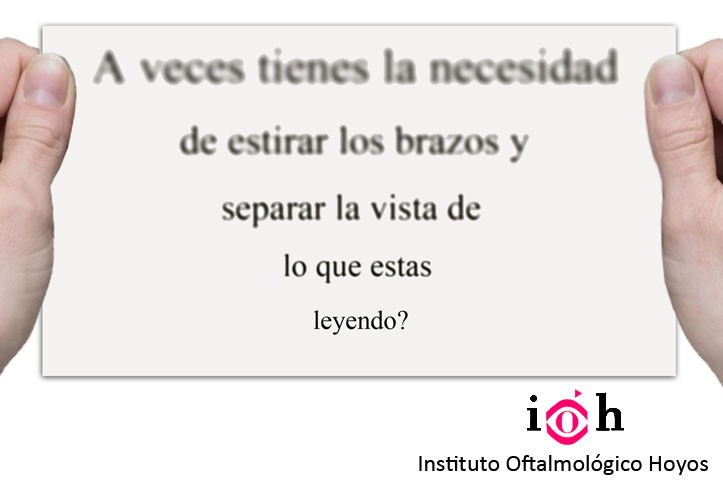PRESBYOPIA
Presbyopia, or eye strain, begins between the ages of 40 and 45, when the crystalline lens, (the eye’s natural lens), loses its elasticity and capacity to focus, thereby causing a loss of clarity in near vision.
When does Presbyopia (eye strain) appear ?
The crystalline lens is the eye’s natural lens, which through the action of the ciliary muscle can change shape. This then allows us to focus on objects in the distance or near to us. In young eyes, the crystalline lens is transparent and flexible and can carry out its function. From the age of 45 onwards, we begin to notice that how well we can read a book depends on gradually holding it further away.The crystalline lens loses its capacity of adaptation for focusing on objects, displaying symptoms of Presbyopia (eye strain) and the solution for many people who find themselves in this situation is to use reading glasses, bifocals or varifocals.
The surgical alternative for Presbyopia are Multifocal Intraocular Lenses.

SURGICAL TECHNIQUE FOR PRESBYOPIA (eye strain).
The surgical technique consists in substituting the crystalline lens for an intraocular lens, which provides a complete range of vision and minimizes one’s dependence on glasses, whether to see in the distance or close up. This surgical procedure is carried out using a local anesthetic, generally with anesthetic eye drops and is on an out-patient basis, taking on average between 20 and 30 minutes. The crystalline lens is eliminated by making a small incision of 2 mm in the cornea, through which a probe is placed. Using ultrasound the crystalline lens is softened and aspirated. The multifocal intraocular lens is flexible and is inserted through the same incision, which, because it is self-sealing, does not need to be sutured. Using this method, vision can be reestablished quickly and generally continues to improve over the following weeks, a time of adaptation to their new vision for patients..
MULTIFOCAL INTRAOCULAR LENSES
Multifocal lenses use optical principles to imitate the function of accommodation which the crystalline lens performs. Light goes through the lens and forms two images, one which is focused, the other unfocused. When we look into the distance, the areas of the lens which are for close vision project an unfocused image, which the brain will eliminate. Contrarily, the areas of the lens which are for far vision will focus on a clear image. When we look at something close up, the opposite occurs. The brain always selects the best image, which allows us to have good vision whatever the distance by only looking at a chosen point and without the necessity of moving our head or eyes. Intraocular lenses are implanted in both eyes and although some people need a few weeks to adapt to this new visual system, the vast majority of patients manage to gain great independence from their glasses.
TYPES OF MULTIFOCAL INTRAOCULAR LENSES
There does not exist a universal multifocal intraocular lens, by which we mean one type of lens which is suitable for all patients. Depending on the characteristics of the eye, the patient’s interests and profession and the lighting conditions which they have in their place of work etc…, the ophthalmologist will recommend that which adapts best to the visual needs of the patient and which will give them the best visual results. We can classify the lenses into three major groups- TRIFOCALS, BIFOCALS and EDOF (lenses with extended depth of focus).
- TRIFOCAL LENSES : These provide good far, intermediate and near vision as they have 3 visual focuses.
- BIFOCAL LENSES : Depending on the model, they provide good far and near vision or far and intermediate vision , as they have 2 principal focus points.
- EDOF LENSES : These are not in fact multifocal lenses, as they do not have various focal points. Instead they have a far focus, which extends up to 40-50 cm from the eye.
CANDIDATES FOR SURGERY
Multifocal implantation is used to correct defects of refraction due to myopia, hyperopia and astigmatism in patients over the age of 40. This is done to achieve the rehabilitation of far and near vision. In addition to this, due to the visual needs of society nowadays, cataracts are operated on earlier and implanting multifocal intraocular lenses when cataract surgery is being performed enables us to rehabilitate vision at different distances.
Not all patients are good candidates for implanting a multifocal lens and it is necessary to have a complete examination of the eye beforehand, including a study of the retina, the pupil, refraction etc…For some patients, these lenses are inadvisable or the result expected will not be achieved and for this reason the patient must receive a complete explanation of the results and visual expectations which await them.
